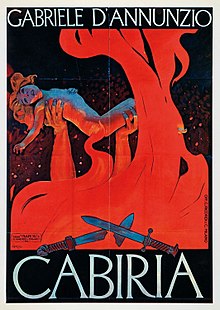
Back Кабирия (филм) Bulgarian Cabiria Catalan Cabiria Czech Cabiria Welsh Cabiria Danish Cabiria German Cabiria Greek Cabiria Esperanto Cabiria Spanish کابیریا Persian
This article has multiple issues. Please help improve it or discuss these issues on the talk page. (Learn how and when to remove these messages)
|
| Cabiria | |
|---|---|
 | |
| Directed by | Giovanni Pastrone |
| Screenplay by |
|
| Based on | A book by Titus Livius and a novel by Emilio Salgari[1] |
| Produced by | Giovanni Pastrone |
| Starring | Bartolomeo Pagano, Lidia Quaranta |
| Cinematography |
|
| Music by | Manlio Mazza Ildebrando Pizzetti |
Production company | |
Release date |
|
Running time |
|
| Country | Italy |
| Languages | Silent Italian Intertitles |
| Budget | £50,000[3] |
| Box office | ₤1 million |
Cabiria is a 1914 Italian epic silent film, directed by Giovanni Pastrone and shot in Turin. The film is set in ancient Sicily, Carthage, and Cirta during the period of the Second Punic War (218–202 BC). It follows the story of an abducted little girl, Cabiria, and features an eruption of Mount Etna, religious rituals in Carthage, the alpine trek of Hannibal, Archimedes' defeat of the Roman fleet at the Siege of Syracuse and Scipio maneuvering in North Africa. Apart from being a classic on its own terms, the film is also notable for being the first film in which the long-running film character Maciste makes his debut. According to Martin Scorsese, in this work Pastrone invented the epic movie and deserves credit for many of the innovations often attributed to D.W. Griffith and Cecil B. DeMille.[4] Among those was the extensive use of a moving camera, thus freeing the feature-length narrative film from "static gaze".
The historical background and characters in the story are taken from Livy's Ab Urbe Condita (written ca. 27–25 BC). In addition, the script of Cabiria was partially based on Gustave Flaubert's 1862 novel Salammbô and Emilio Salgari's 1908 novel Cartagine in fiamme (Carthage in Flames). It was the first film shown at the White House, having been viewed on the South Lawn, by the President, First Lady, Vice President, his wife, members of the Cabinet and their wives, due to the summer heat in June 1914.[5]
- ^ a b c Kinnard & Crnkovich 2017, p. 7.
- ^ "The Greatest Picture.: FILM PLAY "CABIRIA" COMING. : HANNIBAL'S CAMPAIGN CINEMATOGRAPHED". The Critic. Vol. XVI, no. 897. South Australia. 21 April 1915. p. 9. Retrieved 3 April 2019 – via National Library of Australia.
- ^ ""Cabiria." : A Magnificent Film Play. Produced At A Cost Of £50,000". The Mail (Adelaide). Vol. 3, no. 153. South Australia. 17 April 1915. p. 4 (SATURDAY'S NEWS SECTION). Retrieved 3 April 2019 – via National Library of Australia.
- ^ Ebert, Roger (2006-07-02). "The stuff of dreams". Roger Ebert.com. Retrieved 2020-08-11.
- ^ "French Ambassador and Wife Soon to Take Ship for Visit to Paris Home". The Washington Post. June 27, 1914. p. 7.